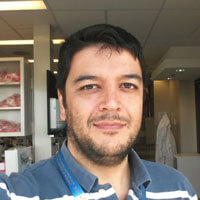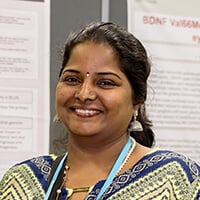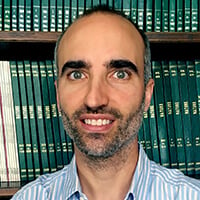The ARVO Foundation for Eye Research established Collaborative Research Fellowships to promote international scientific interactions and innovative research. The program is generously funded by Roche.
This fellowship pairs researchers from developing countries with established scientists to strengthen ophthalmic research capacities. It supports a one-year project, which can include additional training in specialty equipment or research methodologies. Three $10,000 fellowships are available per year.
The award has supported 24 researchers from 11 developing countries since it began in 2009, including Argentina, Brazil, Bulgaria, China, Georgia, Ghana, Hungary, India, Mexico, Romania and Turkey.
Applications open July 1 - Sept. 1
View eligibility details and how to apply
2020 Roche Collaborative Research Fellowship recipients

Pablo Barcelona, PhD
Center for Research in Clinical Biochemistry and Immunology, National University of Cordoba
Argentina
Collaborator
Mike Saphieha, PhD
Maisonneuve-Rosemont Hospital Research Centre
Project title
p75NTR as a potential therapeutic target of proliferative choroidal neovascularization

Wanjiku Mathenge, PhD
Rwanda International Institute of Ophthalmology
Rwanda
Collaborator
Nathan Congdon, MD, PhD
Queen's University Belfast
Project title
Diabetic retinopathy screening using retinal imaging and automated grading with artificial intelligence in Rwanda: A randomized control trial

Sudhir Ranganath, PhD
Siddaganga Institute of Technology
India
Collaborator
Sangly P. Srinivas, PhD
Indiana University
Project title
Rescuing the hypothermia- and cytokine-induced damage to donor corneal endothelial functions by pre-treatment with microtubule stabilizers
2019 Roche Collaborative Research Fellowship recipients

Vicente Bermúdez, PhD
Instituto de Investigaciones Bioquímicas Bahía Blanca
Argentina
Collaborator
Nicolas G. Bazan, MD, PhD, FARVO
LSU Health School of Medicine
Project title
The Phospholipase D (PLD) pathway modulates retinal pigment epithelium (RPE) cells phagocytosis: an insight into signaling at the onset of retinal inflammatory diseases
About Dr. Bermúdez's project
This project is focused on the role that certain lipid signaling enzymes play in the inflammatory response of retinal cells. Since inflammation and oxidative stress are common factors involved in the pathogenesis of several ocular diseases that eventually end in vision loss and blindness, elucidating the molecular mechanisms involved could provide new insights for the treatment of ocular inflammatory diseases. The specific aim of this project is to study the physiological role of the phospholipase D (PLD) pathway, a specific lipid signaling pathway, in retinal cells of great importance, such as retinal pigment epithelium (RPE) cells, exposed to pro-inflammatory injury and oxidative stress. We expect that this project will contribute to understand the molecular basis of inflammatory retinal degenerative diseases such as age-related macular degeneration (AMD), diabetic retinopathy (DR) and uveitis, and open new possible avenues of potential therapeutic exploration.

Daniela Alejandra Quinteros, PhD
Unidad de Investigación y Desarrollo en Tecnología Farmacéutica (UNITEFA)- CONICET
Argentina
Collaborator
Rocío Herrero Vanrell, PhD
Universidad Complutense de Madrid
Project title
Potential neuroprotective effect of antioxidants included in innovative pharmaceutical formulations
About Dr. Quinteros' project
Neurodegenerative eye diseases such as glaucoma, retinitis pigmentosa, diabetic retinopathy, macular degeneration are characterized by being rough and are responsible for the majority of visual dysfunctions and blindness of the world population, they trigger mechanisms of retinal degeneration with death of recipient cells and / or ganglionic whose consequence entails a progressive loss of visual functions. One of the therapeutic strategies aimed at the treatment of these pathologies is neuroprotection. This project proposes the use of synthetic (Melatonin) and natural (Carvacrol and Tymol) neuroprotective oxidizing agents that can prevent, limit, and in some cases reverse, degeneration or death of retinal neuronal cells. Currently, pharmacotherapy seen from this point of view is nonexistent, therefore, if we can generate, through innovative pharmaceutical systems, a potential pharmacotherapy that can vehicularize antioxidant drugs and exert an neuroprotective effect through an eye-level instillation would generate a high impact in the therapeutic.

Swaminathan Sethu, BDS, MSc, PhD
Narayana Nethralaya Foundation
India
Collaborator
Debasish Sinha, PhD
University of Pittsburgh School of Medicine
Project title
Intraocular immune cell profiling in dry age-related macular degeneration
About Dr. Sethu's project
Age-related macular degeneration (AMD) is a vision-threatening condition affecting millions of people worldwide. Of the two varieties of AMD, the wet AMD form currently has some treatment options while the dry AMD form does not have any therapies. There is an immediate need to facilitate the development of targeted therapy for the management of dry AMD. In addition to abnormal inflammation, emerging evidence points to the role of immune cells in retinal degeneration in animal models. This research project is directed at determining the intraocular immune cell subsets and their functional status in dry AMD patients. The findings will be cross-validated in a murine model that mimics pathologic features of dry AMD. The findings from the proposed study will add critical information to the dry AMD knowledgebase and possibly initiate therapeutic strategies, such as harnessing or dampening the local (ocular) immune system in the management of dry AMD.
2018 Roche Collaborative Research Fellowship recipients

Srilekha Sundaramurthy, PhD
Medical Research Foundation, Sankara Nethralaya
India
Collaborator
Patrick Yu-Wai-Man, BMedSci (Hons), MBBS (Hons), PhD, FRCPath, FRCOphth
University of Cambridge and Moorfields Eye Hospital
Project title
Mitochondrial genome landscape analysis in an Indian cohort of Lebers Hereditary Optic Neuropathy (LHON) patients negative to primary mutation (G3460A, G11778A, T14484C)
About Dr. Sundaramurthy's project
Leber Hereditary Optic Neuropathy (LHON) is a mitochondrial genetic disease that is characterized by bilateral, painless, subacute visual failure that develops in the young adult life. Ninety five percent of individuals with LHON harbor any one of the three point mutations in mtDNA according to western literature. From our Indian cohort about sixty-nine percent of suspected LHON cases were negative for the primary mutation. Hence subjecting the primary mutation negative sample to whole mitochondrial sequencing would help us to identify possible causative pathogenic variation in these individuals which might be present in other genes apart from ND1, ND4 and ND6. This study would help us to have a comprehensive mutational landscape analysis in LHON cases and also to know the common polymorphisms which might occur in the controls. This would be the first study to involve the primary mutation negative samples for mitochondrial genome sequencing and to explore the relative frequency of mitochondrial mutations from Indian cohort.

Jeremias Galletti, PhD
Institute of Experimental Medicine, National Academy of Medicine/CONICET
Argentina
Collaborator
Cintia de Paiva, MD, PhD
Baylor College of Medicine
Project title
Characterization of regulatory T cell populations involved in ocular surface immune tolerance
About Dr. Galletti's project
The aim is this project is to identify and characterize the immune cells that are responsible for keeping the ocular surface without inflammation. The eyes are continuously exposed to diverse threats from the environment, yet they become inflamed on seldom occasions. A better understanding of which cells control ocular surface inflammation and how they work could lead to new and better therapies for inflammatory eye disorders, such as dry eye and ocular allergy.

Samuel Kyei, PhD
University of Cape Coast
Ghana
Collaborator:
Lyne Racette, PhD
University of Alabama at Birmingham
Project title
Assessing adherence to glaucoma treatment in Ghana
About Dr. Kyei's project
This project will focus on identifying the rate of adherence in Ghana and on determining the factors associated with adherence in this country. This is innovative because adherence has not yet been measured objectively in Africa. The prevalence of glaucoma in Ghana is high and improving adherence to therapy has the potential to lead to improved treatment outcomes and to the preservation of sight in a high-risk population.
